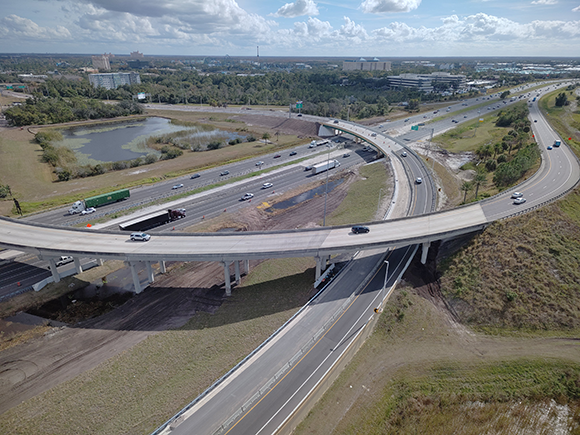Stage 1: Planning – Large projects such as the I-4 Beyond the Ultimate are preceded by long-range studies. Some have been going on for 20 years or more, as the Florida Department of Transportation (FDOT) and other transportation planning agencies monitor population growth, residential development and traffic patterns to anticipate transportation needs.
Stage 2: PD&E – The Project Development and Environment (PD&E) study takes into consideration options for design and location. Each option is analyzed for its environmental, social and economic impact. Proposals also are compared to a no-build option. The Federal Highway Administration (FHWA) reviews the documentation and recommendations of the study. As of last year, the I-4 Beyond the Ultimate project completed this stage and began moving into the design phase.
Stage 3: Design – Detailed design and construction plans are developed. Cost estimates are calculated. Right of way needs are analyzed and purchasing may begin if funding is available. The project is advertised for potential bidders and, after a meticulous review, the contract or contracts may be awarded. The I-4 Beyond the Ultimate project is divided into multiple design segments. Check on the timeline and funding availability of each.
Stage 4: Construction – The building of the roadway, bridges and drainage structures. This work also can include maintenance of traffic plans, landscaping, and creating an electronic backbone to support current and future needs.
All Stages: Public Involvement – Throughout all four stages, FDOT seeks to keep the public informed through several communication platforms and by holding public meetings or open houses to explain plans, answer questions and receive comments.



 ATTENTION DRIVERS: Overnight Closures of the Westbound I-4 Exit Ramp to Eastbound S.R. 528 (Exit 72) January 8, 11-14
ATTENTION DRIVERS: Overnight Closures of the Westbound I-4 Exit Ramp to Eastbound S.R. 528 (Exit 72) January 8, 11-14 S.R. 528 Ramp-Widening Improvements Near Completion
S.R. 528 Ramp-Widening Improvements Near Completion I-4 Beyond the Ultimate: 2025 Wrapped
I-4 Beyond the Ultimate: 2025 Wrapped 60 Never Looked so Good: Happy Birthday, I-4!
60 Never Looked so Good: Happy Birthday, I-4!